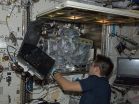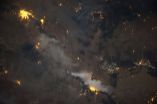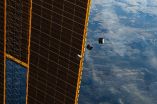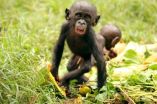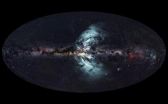HOUSTON, TX, January 03, 2013 (Press-News.org) This past year has been a busy one for the International Space Station. With a variety of new investigations, facilities, researchers, data and results, the space station Program Science Office has had much to share. These investigations benefit life on Earth, inform future space exploration and advance fundamental scientific understanding.
"This has been an amazing year for the space station," said International Space Station Program Scientist Julie Robinson, Ph.D. "We have achieved and exceeded our research goals for the first year of full research use."
Two ongoing investigations that continue to stimulate interest are Robonaut and the Alpha Magnetic Spectrometer-02, or AMS. Robonaut's "human" capabilities are being tested methodically, expanding robotics technology. AMS is collecting charged particles for scientists to sift through to find dark matter and anti-matter. This data could help unlock the secrets of our universe - and possibly change the world of physics. AMS already has measured over 26 billion charged particles.
Human research studies have shown that during their stay aboard the space station, astronauts can combat bone loss by using the Advanced Resistive Exercise Device, or ARED, for high intensity workouts in addition to a proper diet and an intake of vitamin D. This countermeasure also aids in rebuilding their bones once they return to Earth. These studies could have profound effects on future space exploration, as well as the aging population on Earth.
Education investigations, like the YouTube Space Lab competition and others, are part of every expedition and work to inspire students of all ages. YouTube Space Lab had an international following this year, culminating in a live webcast of the winning student investigations performed by Expedition 33 Commander Sunita Williams. More than 2,000 entries focusing on the subjects of physics and biology were received from more than 80 countries.
Physical science investigations - crystal growth, colloid and flame investigations - continue. Each study is adding to the knowledge database. This knowledge expansion provides benefits for future exploration, as well as life on Earth. Some interesting results were discovered in the Flame Extinguishment Experiment, or FLEX. For the first time, researchers observed low-temperature, soot-free "cool" flames - proving two different modes of fuel combustion and flame extinction in microgravity, one was visible to the naked eye and one was not.
Earth and space science investigations include observational studies that look at changes involving pollution; sea levels; urban sprawl and population growth; climate and temperature, along with storms, floods, fires and volcanic eruptions; and other dynamic events. Images taken during these observations provide researchers with data important to understanding the planet from a different perspective and provide a way to track these changes over long periods of time. The information learned from these studies enhances our understanding of Earth science. The International Space Station SERVIR Environmental Research and Visualization System, or ISERV, was delivered to the station last July. It is a remote-controlled Earth imaging system designed to capture imagery of identified areas for environmental studies and disaster analysis from the vantage point of the station.
Researchers are always working to increase the understanding of biological processes in microgravity and how this information can help people on Earth. Two highlights from the past year include studies of fish and yeast organisms. The Aquatic Habitat received its first inhabitants in 2012 - Medaka fish. These translucent fish allow for easy observation of their skeletal systems, providing more insight into bone and muscle atrophy (medical issues for astronauts and the aging population) and radiation effects.
Genotypic and Phenotypic Responses of Candida albicans to Spaceflight, or Micro-6, is studying the health risks of the opportunistic yeast Candida albicans. This yeast is naturally occurring in humans, and researchers want to understand why it becomes more powerful (rapidly reproducing in the human body) and infectious when the human immune system is under stress. What is learned from this study will not only benefit people on Earth who battle this opportunistic pathogen, but it also will benefit future space travelers.
Technology demonstrations also are part of the suite of investigations being examined on the orbiting outpost. One of the many highlights this year is the Robotic Refueling Mission. This mission intends to validate technologies, tools and procedures needed to robotically repair and refuel satellites in orbit. This ability is particularly helpful for extending the service life of many satellites, particularly those not originally built for servicing, referred to as non-cooperative satellites.
Several new facilities were delivered to the space station and allow for an array of new research projects. The Japanese Experiment Module Small Satellite Orbital Deployer, changed the way mini-satellites can be deployed to their optimal orbit, allowing for greater flexibility, operational control and significant monetary savings. A Gravitational Biology Lab also was delivered to the orbiting laboratory. The centrifuge allows for biological experimentation in artificial gravity - from zero gravity to twice Earth's normal gravity - for prolonged periods of time. This lab is useful for biological organism research, and it could lead to advances in medications and vaccines, agricultural controls and discoveries in genetics.
The Center for the Advancement of Science in Space, or CASIS, the nonprofit organization in charge of promoting and managing research aboard the space station's U.S. National Laboratory segment, announced several requests for solicitations. Its current focus is on advancing protein crystallization, materials science and Earth observational science.
With its first commercial resupply service mission, SpaceX has increased the capability to return science samples, among other items, to Earth. The return of these samples expedites research results. This ability also frees up stowage space on the station.
This year also saw the release of the Space Station Benefits for Humanity book, as well as the Space Station Education publication. These publications help the public understand how research in orbit helps people on Earth, and they provide many educational activities to engage students of all ages.
The research carried out aboard the space station continues to provide new insights for scientists. "We see a dramatic increase in scientific publications and their quality," said Robinson. "Extraordinary benefits from this research are developing. The International Space Station is helping to save lives and make our economy stronger." The next ten years should prove to be very exciting regarding new discoveries that will advance human space travel and benefit people on Earth in a host of different arenas.
You can read more about these investigations, and others, on the space station latest news page:
http://www.nasa.gov/mission_pages/station/research/news.html
For more information on past, ongoing, and future ISS research activities, including research results and publications, please visit:
http://www.nasa.gov/mission_pages/station/research/index.html
If you are interested in subscribing to updates from the ISS Program Science Office, please visit:
https://lists.nasa.gov/mailman/listinfo/iss-program-science-group
For more information about the International Space Station, visit:
http://www.nasa.gov/station
For information about NASA and agency programs, visit:
http://www.nasa.gov
2012 International Space Station Research and Discovery Highlights
Release: JR12-029
2013-01-03
ELSE PRESS RELEASES FROM THIS DATE:
Concurrent Technologies Corporation Teams with InfoTech Solutions to Provide Worldwide Intelligence Analysis Services Under the Defense Intelligence Agency's $5.6 Billion SIA II Contract
2013-01-03
Concurrent Technologies Corporation (CTC) announced today that it will team with InfoTech Solutions for Business on a multiple award, multi-year, indefinite delivery/indefinite quantity (IDIQ) contract from the Defense Intelligence Agency (DIA), with a contract ceiling of $5.6 billion over a five-year period. The work will be performed worldwide to provide professional support services to the intelligence analysis mission, warfighters, defense planners, and defense and national security policymakers.
CTC was awarded the original SIA contract in 2008 and executed a variety ...
Bonobos will share with strangers before acquaintances
2013-01-03
DURHAM, N.C. -- You're standing in line somewhere and you decide to open a pack of gum. Do you share a piece with the coworker standing to one side of you, or with the stranger on the other?
Most humans would choose the person they know first, if they shared at all.
But bonobos, those notoriously frisky, ardently social great apes of the Congo, prefer to share with a stranger before sharing with an animal they know. In fact, a bonobo will invite a stranger to share a snack while leaving an acquaintance watching helplessly from behind a barrier.
"It seems kind ...
Risk genes for Alzheimer's and mental illness linked to brain changes at birth
2013-01-03
CHAPEL HILL, N.C. – Some brain changes that are found in adults with common gene variants linked to disorders such as Alzheimer's disease, schizophrenia, and autism can also be seen in the brain scans of newborns.
"These results suggest that prenatal brain development may be a very important influence on psychiatric risk later in life," said Rebecca C. Knickmeyer, PhD, lead author of the study and assistant professor of psychiatry in the University of North Carolina School of Medicine. The study was published by the journal Cerebral Cortex on Jan. 3, 2013.
The study ...
Food for friendship: Bonobos share with strangers in exchange for company
2013-01-03
Bonobos voluntarily share food and will even forego their own meals for a stranger, but only if the recipient offers them social interaction, according to research published January 2 by Jingzhi Tan and Brian Hare of Duke University.
In a series of experiments, the researchers found that bonobos would voluntarily forego their food and offer it to a stranger in exchange for social interaction. The authors found that the bonobos' behavior was at least partially driven by unselfish motivations, since the animals helped strangers acquire food that was out of reach even when ...
ALMA sheds light on planet-forming gas streams
2013-01-03
Astronomers using the Atacama Large Millimeter/submillimeter Array (ALMA) telescope have seen a key stage in the birth of giant planets for the first time. Vast streams of gas are flowing across a gap in the disc of material around a young star. These are the first direct observations of such streams, which are expected to be created by giant planets guzzling gas as they grow. The result is published on 2 January 2013 in the journal Nature.
The international team of astronomers studied the young star HD 142527, over 450 light-years from Earth, which is surrounded by a ...
Nature: Political action the biggest swing factor in meeting climate targets
2013-01-03
The new study, published today in the journal Nature, examined the probability of keeping average global temperatures from rising more than 2°C above preindustrial levels under varying levels of climate policy stringency, and thus mitigation costs. In addition, the study for the first time quantified and ranked the uncertainties associated with efforts to mitigate climate change, including questions about the climate itself, uncertainties related to future technologies and energy demand, and political uncertainties as to when action will be taken.
The climate system itself ...
Our galaxy's 'geysers' are towers of power
2013-01-03
VIDEO:
This is Ettore Carretti talking about how the telescope makes maps of the sky.
Click here for more information.
"Monster" outflows of charged particles from the centre of our Galaxy, stretching more than halfway across the sky, have been detected and mapped with CSIRO's 64-m Parkes radio telescope.
Corresponding to the "Fermi Bubbles" found in 2010, the outflows were detected by astronomers from Australia, the USA, Italy and The Netherlands. The finding is reported ...
Study refutes accepted model of memory formation
2013-01-03
A study by Johns Hopkins researchers has shown that a widely accepted model of long-term memory formation — that it hinges on a single enzyme in the brain — is flawed. The new study, published in the Jan. 2 issue of Nature, found that mice lacking the enzyme that purportedly builds memory were in fact still able to form long-term memories as well as normal mice could.
"The prevailing theory is that when you learn something, you strengthen connections between your brain cells called synapses," explains Richard Huganir, Ph.D., a professor and director of the Johns Hopkins ...
ALMA shows how young star and planets grow simultaneously
2013-01-03
Astronomers have used the ALMA telescope to get their first glimpse of a fascinating stage of star formation in which planets forming around a young star are helping the star itself continue to grow, resolving a longstanding mystery. The young system, about 450 light-years from Earth, is revealing its complex gravitational dance to the ever-sharpening vision of the Atacama Large Millimeter/submillimeter Array (ALMA), scheduled for completion this year.
As young stars gather material from their surrounding clouds of gas and dust, the incoming material forms a flat, spinning ...
Galactic geysers fuelled by star stuff
2013-01-03
Enormous outflows of charged particles from the centre of our Galaxy, stretching more than halfway across the sky and moving at supersonic speeds, have been detected and mapped with CSIRO's 64-m Parkes radio telescope.
Corresponding to the "Fermi Bubbles" found in 2010, the recent observations of the phenomenon were made by a team of astronomers from Australia, the USA, Italy and The Netherlands, with the findings reported in today's issue of Nature.
"There is an incredible amount of energy in the outflows," said co-author Professor Lister-Staveley-Smith from The University ...
LAST 30 PRESS RELEASES:
Making lighter work of calculating fluid and heat flow
Normalizing blood sugar can halve heart attack risk
Lowering blood sugar cuts heart attack risk in people with prediabetes
Study links genetic variants to risk of blinding eye disease in premature infants
Non-opioid ‘pain sponge’ therapy halts cartilage degeneration and relieves chronic pain
AI can pick up cultural values by mimicking how kids learn
China’s ecological redlines offer fast track to 30 x 30 global conservation goal
Invisible indoor threats: emerging household contaminants and their growing risks to human health
Adding antibody treatment to chemo boosts outcomes for children with rare cancer
Germline pathogenic variants among women without a history of breast cancer
Tanning beds triple melanoma risk, potentially causing broad DNA damage
Unique bond identified as key to viral infection speed
Indoor tanning makes youthful skin much older on a genetic level
Mouse model sheds new light on the causes and potential solutions to human GI problems linked to muscular dystrophy
The Journal of Nuclear Medicine ahead-of-print tip sheet: December 12, 2025
Smarter tools for peering into the microscopic world
Applications open for funding to conduct research in the Kinsey Institute archives
Global measure underestimates the severity of food insecurity
Child survivors of critical illness are missing out on timely follow up care
Risk-based vs annual breast cancer screening / the WISDOM randomized clinical trial
University of Toronto launches Electric Vehicle Innovation Ontario to accelerate advanced EV technologies and build Canada’s innovation advantage
Early relapse predicts poor outcomes in aggressive blood cancer
American College of Lifestyle Medicine applauds two CMS models aligned with lifestyle medicine practice and reimbursement
Clinical trial finds cannabis use not a barrier to quitting nicotine vaping
Supplemental nutrition assistance program policies and food insecurity
Switching immune cells to “night mode” could limit damage after a heart attack, study suggests
URI-based Global RIghts Project report spotlights continued troubling trends in worldwide inhumane treatment
Neutrophils are less aggressive at night, explaining why nighttime heart attacks cause less damage than daytime events
Menopausal hormone therapy may not pose breast cancer risk for women with BRCA mutations
Mobile health tool may improve quality of life for adolescent and young adult breast cancer survivors
[Press-News.org] 2012 International Space Station Research and Discovery HighlightsRelease: JR12-029
